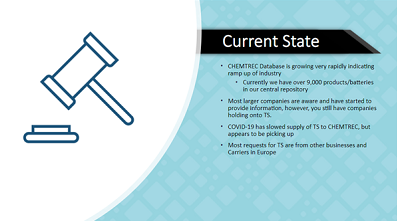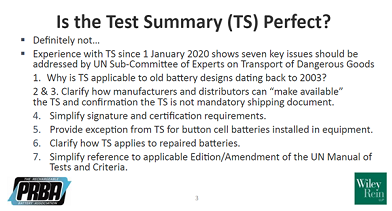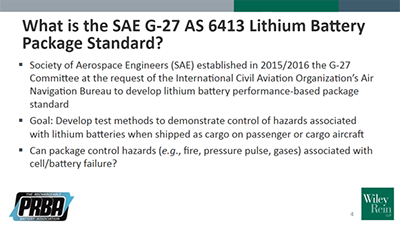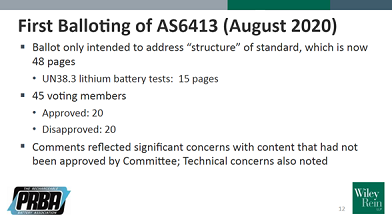
Over the years, the most popular day of the Dangerous Goods Symposium has been Lithium Battery Day. Everyone’s favorite Class 9 Miscellaneous material always seems to make the most news, stir up the most controversy and inspire the most teeth-gnashing.
This year, with the Symposium taking place virtually at the new DG Exchange, we were able to blow out that single day into the first-ever Lithium Battery Week. Hazmat geeks, rejoice!
The first three sessions of this epic knowledge-fest are in the books. Here’s a brief recap of each one. (Skip to the end to find links for the remaining sessions.)
Proposed changes to lithium battery test summary requirements
In January, 2020, a new IATA rule went into effect requiring organizations that manufacture or distribute lithium batteries and/or devices to make available test summaries proving their batteries meet UN 38.3 testing standards. Two of the people helping the industry deal with this new requirement spoke on Monday:
- Kevin Bryan, Senior Business Development Manager at CHEMTREC
- George Kerchner, Executive Director of PRBA – The Rechargeable Battery Association.
At CHEMTREC, where Bryan’s team is compiling a database of test summaries for its members, “It’s taking longer than expected but we’re making very good progress,” he said. “There’s been a nice uptick in how quickly we’re running through requests.”

He said international suppliers and decentralized organizations have made it more difficult to track down summaries. “People are sometimes unaware of the information and don’t know who to contact. When you reach someone, they may not understand what you’re asking for. Or someone at US company may recommend contacting ‘my counterpart in Europe, but I’m not sure who that is.’”

Kerchner said the test summary requirement is working, but far from perfect—and described seven key issues PRBA is urging the UN sub-committee to address.

Two of the most important: Emphasizing that test summaries are NOT mandatory shipping documents, and clarifying how the rule does (and doesn’t) apply when batteries have been refurbished. “Once a battery has been removed and modified,” he said, “our concern is that the original manufacturer is still on the hook. Under our proposed note, the company that has modified the battery design would be responsible for creating their own test summary.”
Watch the complete session here.
Digital delivery for lithium battery training
What can go wrong during an online lithium battery training session? How about … everything?
After sharing this video (which appeared to be part of the live session) on Tuesday, Geoff Leach, Director of The Dangerous Goods Office Ltd. and Trevor Howard, Manager, Cargo Standards & Operational Safety at Emirates, discussed their experiences this year with virtual training necessitated by the COVID-19 pandemic.
Leach said, “I’d much rather be in a classroom with students,” and described challenges with logistics, interruptions, and keeping students engaged. A new process for securely and confidentially administering tests was “not perfect, but none of us have ever faced this situation before. We have to accept a little bit of risk that the process was not as rigorous as we would have wanted.”
At Emirates, nearly all training had to transition to online when the carrier’s global destinations were reduced by nearly 75%—but as of September 1, they were 100% current on training. Now, Howard cites lack of travel as a potential positive of the online training experience.
“We used to have people come into Dubai from all over the world, spending days away from their office.,” he said. “We still believe in classroom training but will continue with a blend.”
Watch the complete session here.
Updates on SAE’s G27 Lithium Battery Packaging Standards
Kerchner returned Wednesday to describe the efforts of the Society of Aerospace Engineers to define standards for lithium-ion battery packaging that would be considered safe for transport on passenger aircraft. (ICAO banned the transport of standalone lithium-ion batteries as cargo on passenger planes in 2016.)

“We’re in our fifth year, heading into our sixth year. When we started there was hope we’d be done in a year or two. We’ve made a lot of progress but there’s still plenty of work to be done.”
Developing the testing methods for this standard has proven to be exceedingly complex. “There must be ten ways to initiate thermal runaway,” Kerchner said. “And repeatability is a common discussion. With any new test standard there will be hundreds of labs doing tests, and they have to be able to follow the same procedures.”

How complex is this issue? The first ballot put to the committee members was 48 pages long—“More than three times the length of the UN 38.3 standards,” Kerchner pointed out.
So when will the standards likely go into effect?
“When we establish the standard, it will be up to ICAO to adopt it into rules,” he said. “There will be lengthy, lengthy meetings and debates. I wouldn’t be surprised if we didn’t finish until 2023.”
Watch the complete session here.
Coming up at the DG Symposium
Friday, Sept. 18: Live Expert Panel Discussion. Get your questions answered and your opinions challenged by our expert lithium battery panel. We oughta sell popcorn for this one.
Thursday, Sept. 24: Regulatory Updates—Session 2. Duane Pfund (PHMSA), Dave Brennan (IATA) and Diego Gotelli (CIQUIME) share key regulatory updates from the UN, IATA/IACO and Latin America.
Make sure your shipments are safe and in complete compliance with a full line of solutions from Labelmaster—a full-service provider of goods and services for hazardous materials and Dangerous Goods professionals, shippers, transport operators and EH&S providers.


